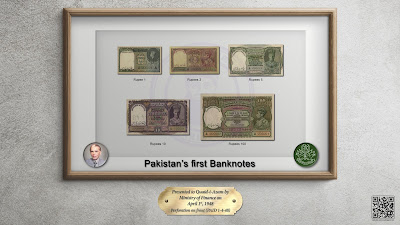Following advice from an expert committee, the Governor-General of undivided India issued the ‘Pakistan (Monetary System and Reserve Bank) Order, 1947’ on August 14th, 1947, the day before partition. Under this order, the Reserve Bank of India was to be the common currency authority for India and Pakistan until September 30th, 1948, with notes issued by the Reserve Bank of India and the Government of India remaining legal tender in Pakistan until the same date. The order also allowed for notes issued by the Reserve Bank of India and the Government of India to be inscribed with ‘Government of Pakistan’ in Urdu and English and placed into circulation from April 1st, 1948 under the responsibility of the Government of Pakistan. So, following seven months where notes of the Reserve Bank of India and the Government of India continued to circulate in Pakistan, modified notes of the Reserve Bank of India in the denominations of Rs. 2/-, 5/-, 10/- and 100/- rupees were introduced as planned, along with modified 1-rupee note of the Government of India.
Pakistan's first banknotes were presented to Quaid-i-Azam on April 1st, 1948 by the Ministry of Finance. All the notes have the serial number of 000001and a perforation on front side (PAID 1-4-48).
The modification to the Indian notes consisted of two inscriptions on the front of the notes. At the top of the white area reserved for viewing the watermark the words ‘GOVERNMENT OF PAKISTAN’ were inscribed in English, while at the bottom of the white area the Urdu rendition of the same phrase appears, i.e. ‘Hakumat-e-Pakistan’ -حکومت پاکستان. It is important to note that these inscriptions are due to modifications to the printing plates and they are not ‘overprints’. This distinction is important, as there have been attempts to dupe collectors by overprinting notes of the Reserve Bank of India with the relevant inscriptions. All other details of the inscribed notes were the same as their counterparts, which continued to circulate in Pakistan and India.








No comments:
Post a Comment